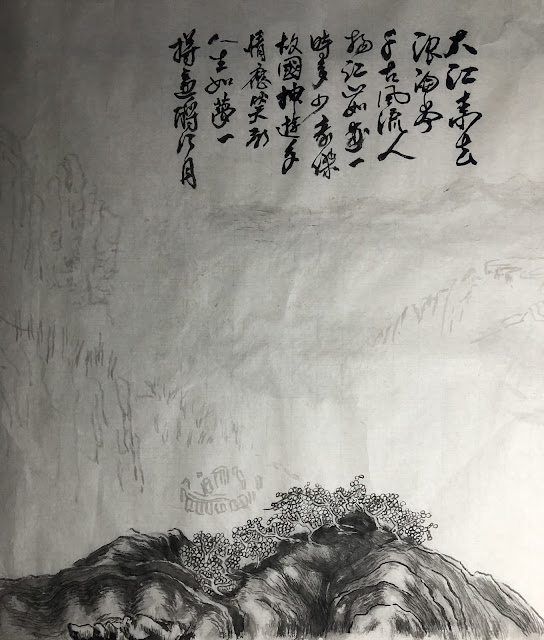Now that I have the calligraphy in the bag, I can proceed in earnest to work on my painting.
As I mentioned in my last blog, the verses are from the famous Song Dynasty scholar/official Su Shi (Su Dongpo) when he visited Chibi and was being sentimental while reminiscing the historical events that happened some 800 prior. The Battle of Chibi ( English translation Battle of the Red Cliffs) was about a naval war between adversaries and the outcome depended on a change of wind direction. Which way the wind blew was vital because fire was employed as the tactic in this conflict. Whoever could predict and take advantage of the change of wind direction became the victor. The exact location of Chibi is still highly debated, but suffice to say that it is along the Yangtze River.
The Columbia River Gorge in the Pacific Northwest is a designated National Scenic Area and the town of Hood River has the distinct honor of being the Windsurfing Capital of The World. This section of the gorge compresses the east-west wind and amplifies its magnitude. On windy days tourist would venture up to the Vista House on top of Crown Point and try to stand up unassisted in the 70 mph winds. When the east wind blows, we get dry heat funneling through from the east in the summer, and cold frigid winds in the winter. Westerly wind brings moderation and weather system from the Pacific Ocean. Present day Gorge is dotted with wind turbines now.
Farther east from the Vista House, we have the famous Falls area, Multnomah Falls being the most well known. Beyond that near the cities of Mosier and The Dalles lies the serpentine stretch of Historic Columbia Rivery Highway, where cyclists and motorists alike enjoy the challenge of the winding blacktops. At the end of such switchbacks is the Rowena Loop, which is a circular drive at the Rowena Crest Viewpoint where one can enjoy the Columbia River down below. Spring wild flowers and birds harnessing the updraft from the cliffs for take-offs make this Viewpoint a popular respite for travelers. Thirty minutes car ride east across the river from the loops gets one to the Maryhill Museum, Maryhill Winery and the adjacent Stonehenge replica.
What if I utilize all these vistas and the Columbia River as a backdrop for my painting? I think it is a perfect setting for reminiscing and it reflects the spirit of the meaning effused by the verses from Su. I also find a special connection with and relate to the wind in the river gorge. I can definitely visualize a battle involving the use of fire being carried out here.
I am making up some rules for me to follow in doing this painting. One is I shall not hurry. Two is I shall try to present the painting with more classical means of depiction and brushstrokes. Three is I shall incorporate each of the four vistas mentioned and each vista can be viewed as a painting by itself.
I am starting with a sketch of my main points of interest and the general layout of the proposed painting. This makes it much easier for me to work on individual sections later. Somehow I feel more disciplined this way, and more apt to take my time in developing the details.
First come the Stonehenge, occupying the lower left hand corner of the painting.
A more developed painting, with light values and initial texturing. Notice the classical presentation of foliage.









